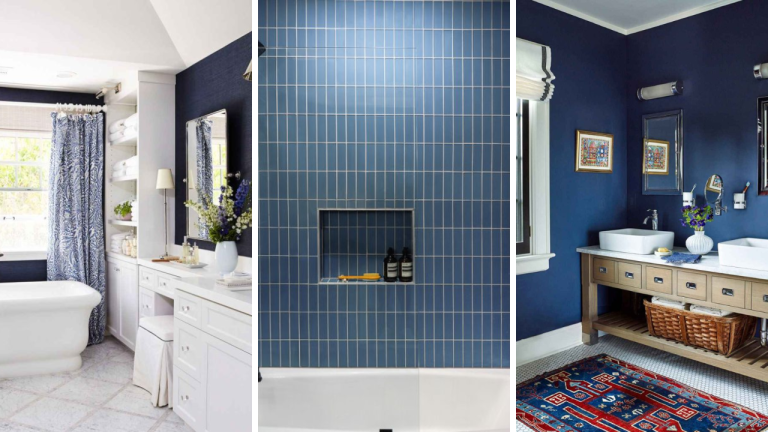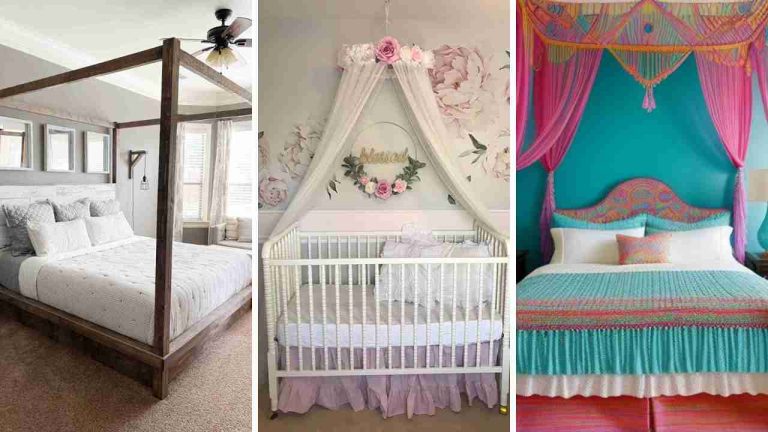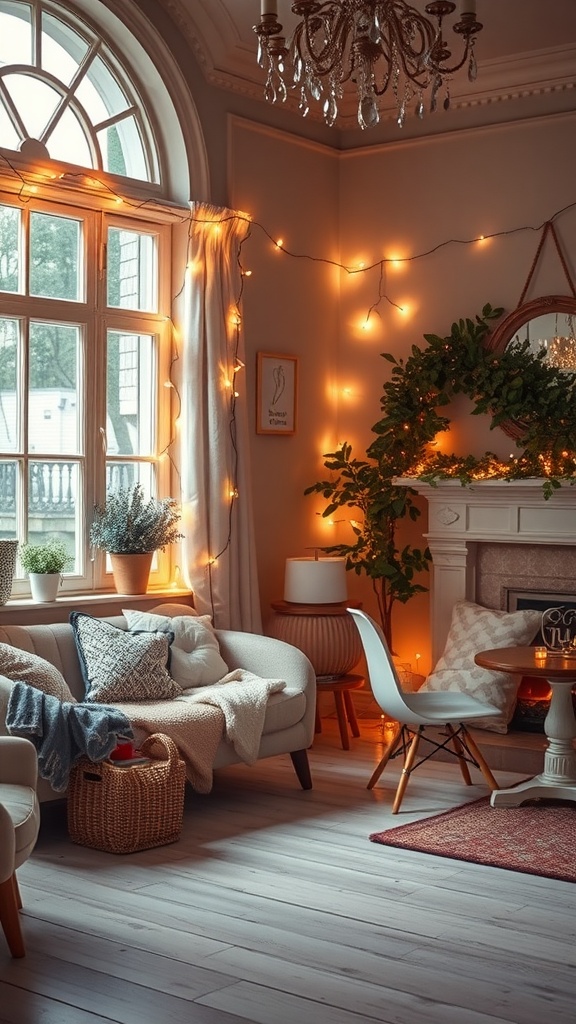Small bedrooms can be cozy and charming when styled the right way. In this collection of 29 small room bedroom ideas, you’ll find practical tips and creative solutions to maximize your space without sacrificing comfort or style. Whether you’re working with tight quarters or looking for clever storage hacks, these inspirations will help you transform your small bedroom into a tidy and inviting retreat.
Incorporating Foldable or Expandable Furniture
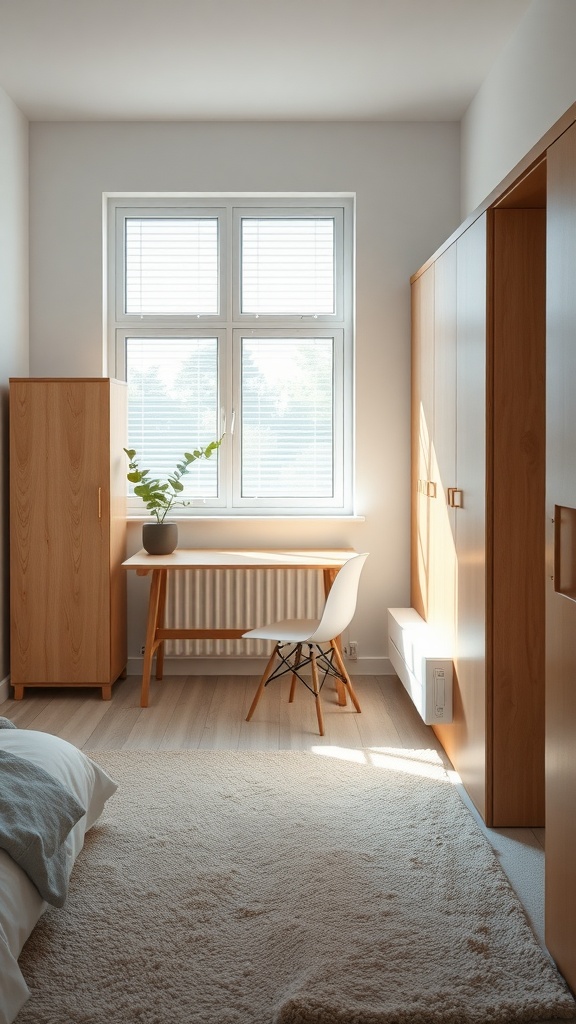
When dealing with a small bedroom, using foldable or expandable furniture can make a big difference. In the image, we see a well-organized space that highlights this concept. The desk and chair blend functionality with style, keeping the area open and inviting.
The room features a lovely plant that adds a touch of nature, while the natural light streaming through the window brightens everything up. This setup encourages a sense of tranquility and productivity.
Choosing furniture that can be easily stowed away or expanded when needed maximizes the space. A foldable desk can be tucked away when not in use, making room for other activities. Similarly, a chair that can fold up is a smart option.
Overall, the design here emphasizes simplicity and practicality. It’s all about finding pieces that fit your lifestyle without overwhelming your space. By incorporating foldable or expandable furniture, you can create a stylish, functional small room bedroom that feels roomy and accommodating.
Creating an Illusion of Space with Mirrors

In a small bedroom, mirrors can work wonders. They reflect light and create a sense of openness, making the room feel larger than it is. In the image, you can see how the two mirrors positioned strategically against the wall enhance the light coming in from the window. This clever arrangement offers depth, pulling the eye toward the reflections.
The use of mirrors is not just practical; it’s also stylish. They can serve as decorative elements, adding a modern touch to your space. Notice how the warm tones of the wood frames complement the cozy bedding. This harmony in design allows the mirrors to blend seamlessly into the room while still being functional.
Another advantage of using mirrors is that they can bring life to corners that might otherwise feel empty. In this setting, the mirrors are not just reflecting the bed; they also bounce back the warm light, creating an inviting atmosphere. When choosing mirrors, consider sizes and shapes that fit your personal style, whether it’s sleek and minimalist or ornate and vintage.
Overall, incorporating mirrors into your small bedroom design can help you achieve that airy, spacious feel. This simple trick can transform how you perceive your space without the need for major renovations or additions.
Incorporating Vertical Storage Solutions

In small room bedrooms, every inch counts. Utilizing vertical storage can dramatically change how you organize your space. The image showcases a cozy bedroom with cleverly designed shelving that reaches toward the ceiling. This setup maximizes storage without taking up precious floor space.
The tall bookshelf is not just practical, but it also enhances the room’s style. It holds books, decorative items, and personal treasures, making the room feel inviting. Consider how you can display your favorite books or mementos in a similar way. It’s a great conversation starter!
Additionally, the bed has built-in drawers, which offer extra storage for clothes or linens. This ensures that even under the bed, you’re utilizing available space efficiently. Pairing vertical storage with multi-functional furniture can help keep your room tidy.
Think about adding hooks or wall-mounted shelves for items like bags or accessories. This keeps your belongings off the floor and easily accessible. By thinking vertically, you can create a room that feels open and organized, even in limited square footage.
Utilizing Under-Bed Storage Options
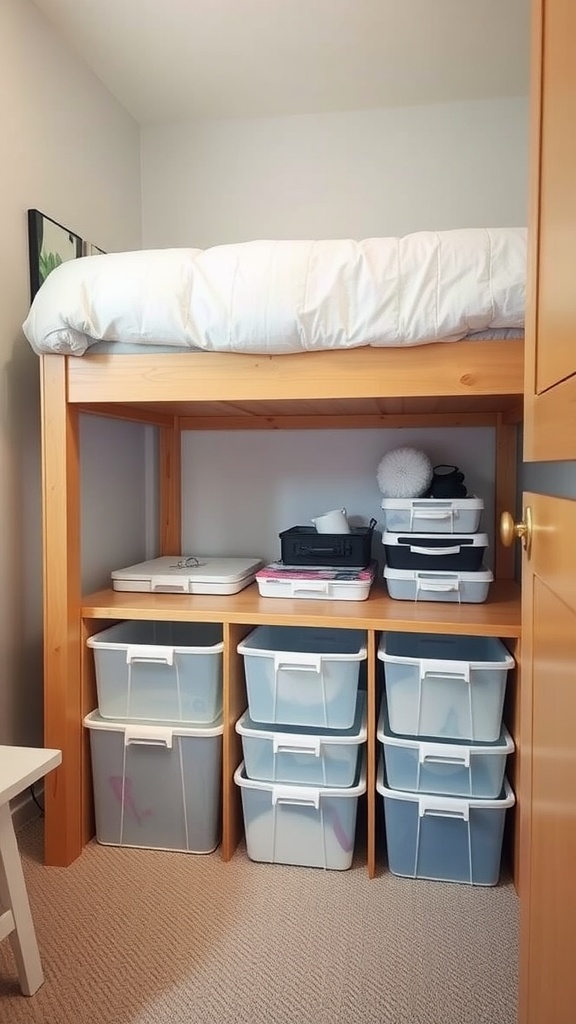
In a small bedroom, every inch counts, especially when it comes to storage. The image shows a clever use of under-bed space, which is often overlooked in design. By raising the bed, a whole new area opens up for organizing belongings.
The space beneath the lofted bed is neatly arranged with clear storage bins. This keeps items visible and accessible, making it easy to find what you need. It’s a smart way to keep things tidy without sacrificing style.
Consider various types of storage options. For instance, stackable bins can maximize vertical space, while labeled containers allow for easy identification of contents. This setup not only clears clutter but also adds a touch of organization to your small room.
Using the area under your bed creatively can transform your small bedroom experience. Think about what items you use frequently and store away seasonal things like clothes or holiday decorations. This way, you keep your space functional and inviting.
Layering Textures for Visual Interest
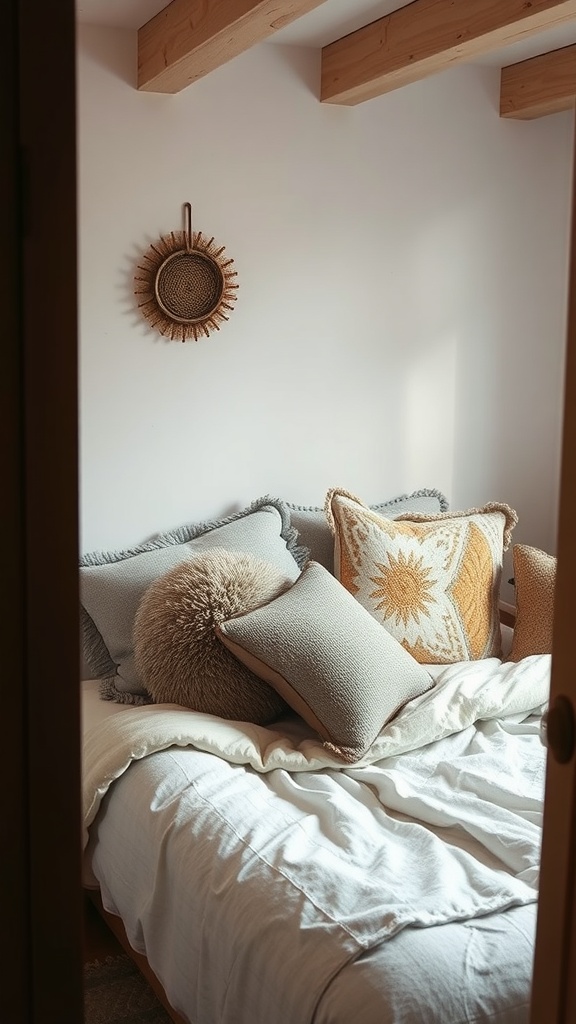
When it comes to small bedrooms, creating a cozy and inviting space is key. One way to achieve this is by layering textures. The image showcases a beautifully styled bed with an array of pillows, each adding its own unique touch.
The fluffy throw pillow brings a sense of warmth, while the patterned cushion adds a pop of visual interest. These elements work together to create a welcoming atmosphere that makes you want to snuggle in and relax.
Additionally, the soft bedding contrasts nicely with the handcrafted wall hanging, further enhancing the overall aesthetic. This combination of textures not only makes the space feel more dynamic but also invites a sense of comfort and homey charm.
In a small room, every detail counts. By mixing different fabrics and patterns, you can create an inviting look that feels both stylish and personal. Don’t shy away from experimenting; layering textures is all about finding the right balance that reflects your personality.
Using Light Colors to Brighten the Room

Light colors can work wonders in a small bedroom. They make the space feel larger and more open. In the image, we see a bedroom that perfectly illustrates this idea. The walls and flooring are painted in soft white tones, which creates a bright, airy atmosphere.
The yellow bed frame pops against the light background, adding a cheerful touch without overwhelming the senses. Simple decor, like the pink nightstand and lamp, adds a bit of warmth while still keeping the room feeling light and spacious.
Natural light enhances the overall effect. The sunlight streaming through the window casts gentle shadows, creating a cozy vibe. This balance of light colors and natural light can help make even the smallest rooms feel inviting and comfortable.
When decorating your small bedroom, consider using light shades for your walls, furniture, and accessories. Soft pastels or crisp whites can transform the space, making it feel more welcoming. Keep in mind that the right lighting can also play a significant role in how colors appear. Layering light sources can make the room feel bright without cluttering it visually.
Choosing Multi-Functional Furniture
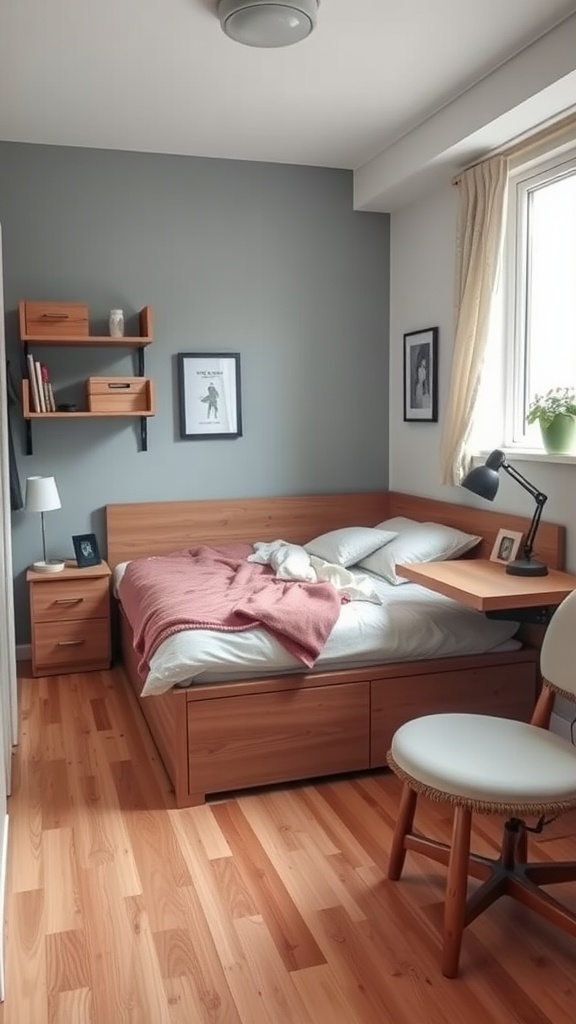
In small bedrooms, every inch counts. The image shows a cozy room that cleverly uses multi-functional furniture to maximize space. The bed has built-in storage, allowing for hidden storage solutions that keep the area tidy and organized.
Notice how the desk is integrated into the bed frame. This setup saves space while providing a functional workspace. It’s perfect for those who might need a small area to study or work without taking up extra room.
Also, the shelving on the wall adds vertical storage. This is a smart way to display books or decorative items without crowding the floor. Having wall-mounted shelves frees up valuable real estate and keeps the room feeling open.
Lastly, the choice of light colors and natural wood tones in the furniture keeps the room feeling airy. This design approach helps to make a small space feel more inviting. Choosing the right multi-functional pieces can transform a tiny bedroom and make it feel more livable.
Selecting Space-Saving Nightstands
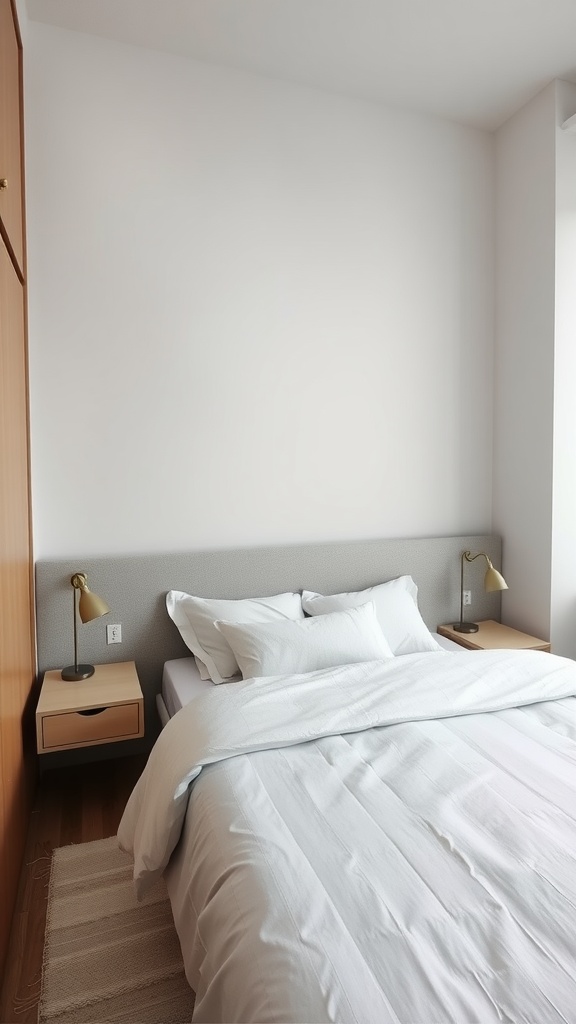
When dealing with a small room bedroom, choosing the right nightstand is key. The image shows a cozy setup where space is maximized without sacrificing style. Notice the clean lines of the nightstands on either side of the bed? They bring functionality and elegance to the room.
One great idea is to opt for nightstands that offer storage. Look for designs with drawers or open shelves. This way, you can keep essentials close by while maintaining a clutter-free space. The light fixtures mounted above the nightstands also save surface space, making the area feel open and airy.
Don’t forget about the materials. Light woods or neutral colors can make a small room feel larger. In the image, the light wood of the nightstand matches the overall bright aesthetic, creating a seamless look. Try to find pieces that complement your bedding and other furniture to give your small bedroom a cohesive feel.
Color Blocking for a Fun Aesthetic

Color blocking is a playful way to bring life into small spaces. In this cozy bedroom, vibrant hues create an inviting atmosphere. The warm orange wall adds energy, while the calming teal ceiling introduces a refreshing touch.
The combination of these colors is not only fun but also visually stimulates the space. Notice how the lower green trim balances the bright walls, making the room feel grounded. This technique works wonders in small bedrooms, as it creates depth without overwhelming the senses.
The patterned bedding showcases bold colors that tie in with the walls. It’s a great way to incorporate more color without being too intensive. A simple bedside table and lamp complete the look, keeping the space functional yet stylish.
Using color blocking is a smart choice for anyone looking to enhance their small room. It allows for creativity and personalization, turning a basic bedroom into a lively retreat.
Hanging Art at Eye Level

When designing a small bedroom, every detail counts, including the way you display art. The images shown above highlight how hanging art at eye level can make a cozy room feel more inviting. Arranging pieces in a gallery style draws the eye and creates a sense of balance.
In this setup, a mix of artwork frames in different colors adds character to the wall. The choice of subjects, from animals to human figures, provides a personal touch. This variety not only sparks interest but also allows for easy conversation starters when friends visit.
One important tip is to ensure that the center of your arrangement is at eye level, generally around 57 to 60 inches from the floor. This makes it comfortable to view the artwork while sitting or standing. The wall art becomes a focal point of the room, enhancing its overall charm.
Additionally, framing styles can complement your bedroom’s decor. For example, wooden frames can add warmth, while black frames create a classic look. Mixing these can give a collected-over-time vibe, which is perfect for small spaces.
Creating a Cozy Reading Nook
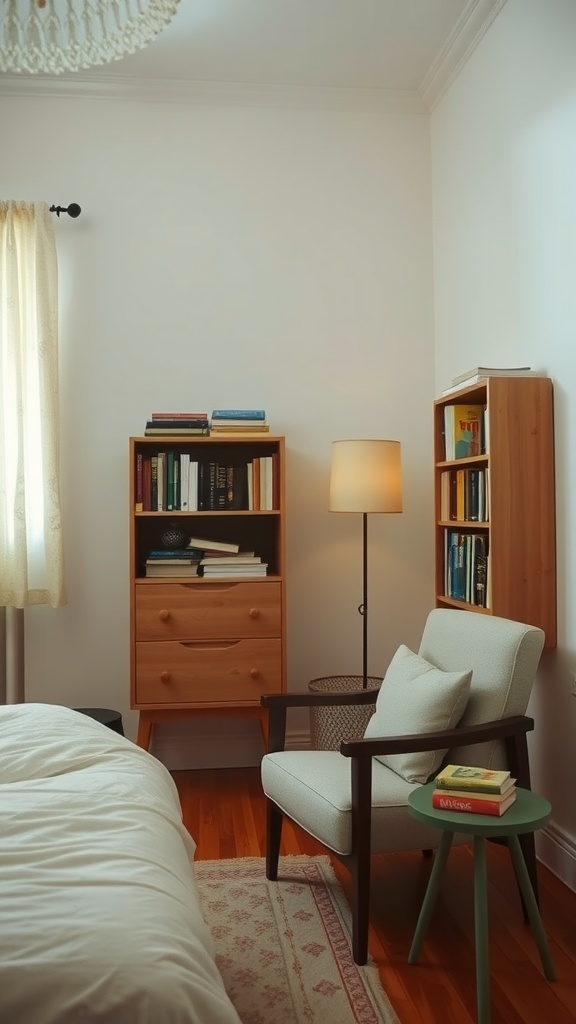
In a small room bedroom, every inch counts. This image beautifully captures a cozy reading nook that makes the most of the available space. The light-colored walls and warm wooden floors create a welcoming atmosphere, perfect for curling up with a good book.
The comfy chair is a great focal point, inviting relaxation. It’s placed next to a small side table, where you can easily set down your drink or a stack of books. Having a lamp nearby means you can read comfortably without straining your eyes.
On the shelves, you can see a variety of books neatly organized, making it easy to grab your favorites. The combination of natural light from the window and the soft glow of the lamp sets a tranquil mood, perfect for unwinding at the end of the day.
To add a personal touch, consider decorating the nook with a small plant or a few framed pictures. This makes the space feel even more inviting and adds a splash of your personality to the room.
Maximizing Closet Space with Organizers
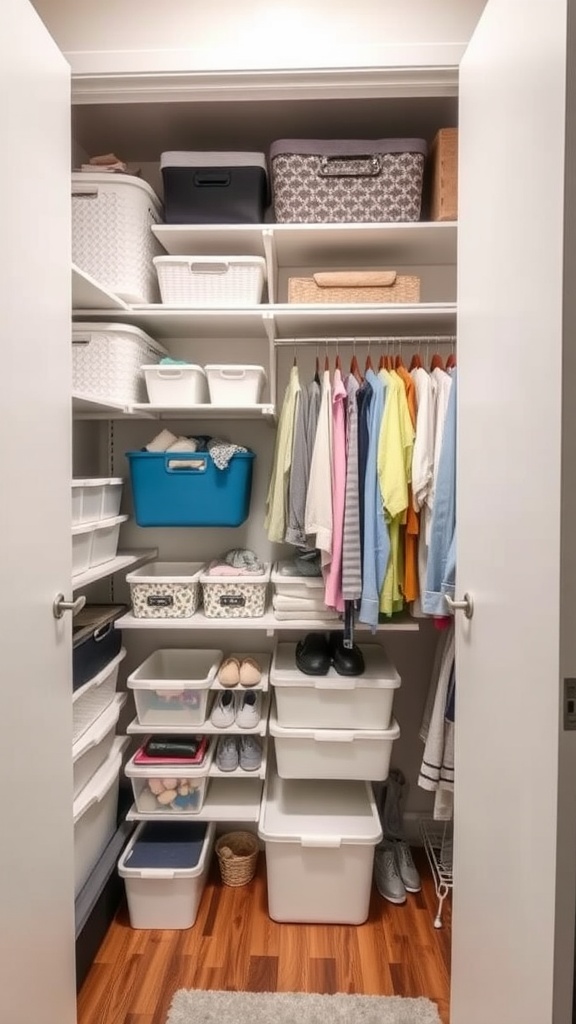
In a small bedroom, every inch counts, especially when it comes to closet space. The image showcases a well-organized closet that offers lots of ideas for maximizing storage.
Using a mix of baskets, bins, and shelves helps keep everything neatly in place. The bright colors of the bins add a fun touch and make it easy to identify what’s inside. Notice how the top shelves hold larger items while the lower sections are reserved for shoes and smaller containers.
Hanging clothes in an organized way also saves space. By using hangers efficiently, you can fit more items without cramming. This closet design encourages easy access, so you won’t waste time searching for what you need.
Using dividers in the drawers can keep smaller items separated, preventing clutter. This simple step goes a long way in maintaining a tidy look. Overall, the approach seen here shows how thoughtfully selected organizers can transform a small closet into a highly functional space.
Using Light Fixtures to Enhance Ambiance
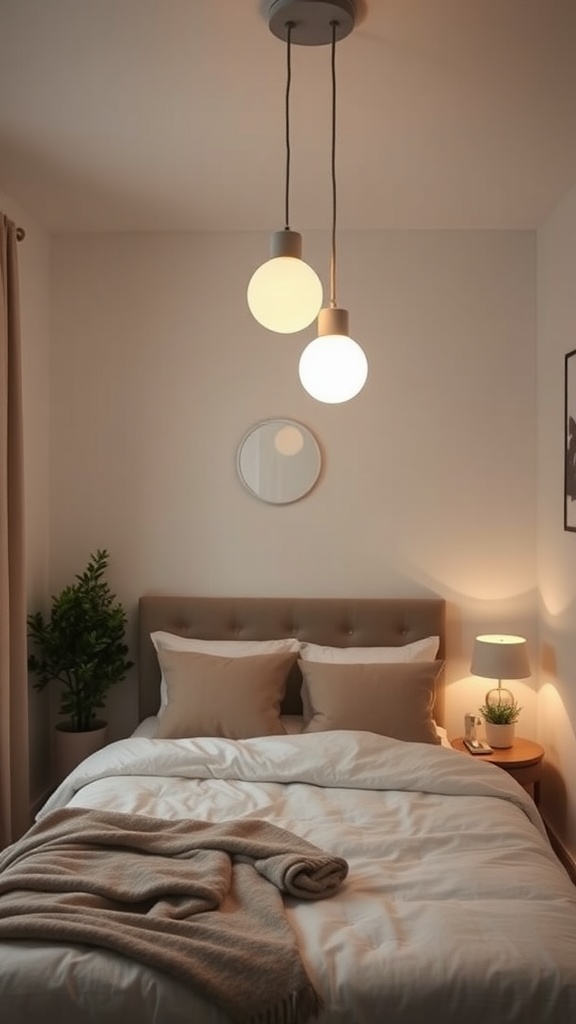
In a small bedroom, lighting can transform the space and create a cozy atmosphere. The image showcases a neatly made bed adorned with soft pillows and a warm blanket, inviting relaxation. Overhead, three pendant lights hang gracefully, offering a soft glow that enhances the room’s comfort.
Choosing the right light fixtures is key in a bedroom. The three bulbs in this design blend functionality with style. The variation in light intensity adds depth, making the room feel more spacious and inviting. For smaller spaces, consider using fixtures that draw the eye upward, as this creates an illusion of height.
A bedside lamp contributes to the ambiance as well. It allows for a more intimate lighting option, perfect for winding down at the end of the day. The gentle light can make reading in bed a delightful experience, adding to the warmth of the space.
Don’t forget about natural light! Keeping windows unobstructed during the day can maximize sunlight, making the room feel airy. Combining natural light with your chosen fixtures can create a harmonious balance that enhances the overall atmosphere.
Incorporating Plants for Freshness
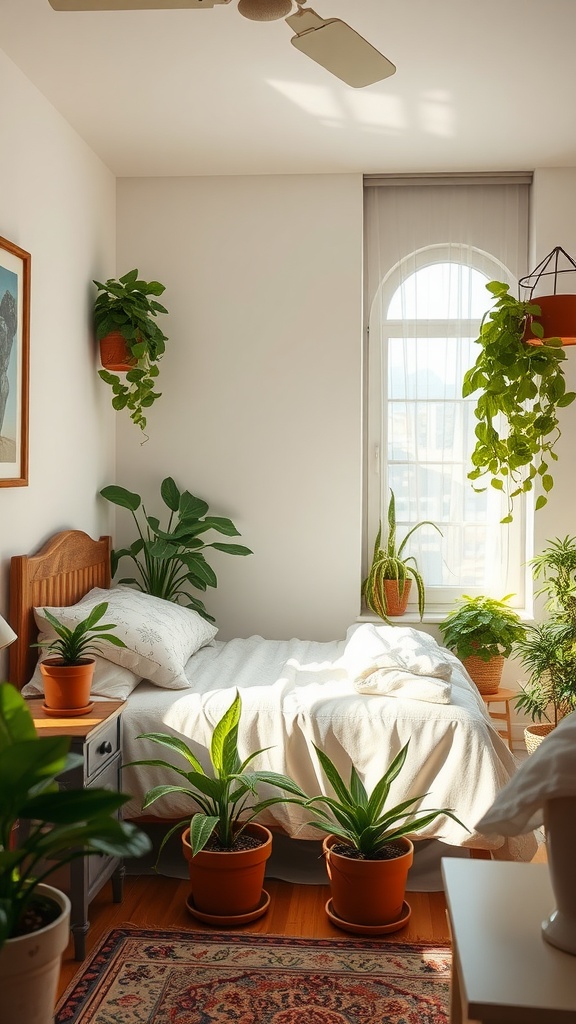
Adding plants to a small bedroom can transform the space into a refreshing oasis. In the image, you can see how vibrant greenery breathes life into the room. The plants not only look lovely but also improve air quality, making the environment feel more inviting.
Notice how the plants are strategically placed around the bed. This setup creates a cozy atmosphere without overwhelming the small space. Hanging plants near the window catch the light beautifully, while potted plants on the floor add a touch of nature at eye level.
Choosing low-maintenance plants can make this easier for anyone, especially if you’re new to indoor gardening. Consider varieties like snake plants or pothos, which thrive in various light conditions. Placing them in terracotta pots adds a warm, earthy vibe that complements the serene color palette of the room.
Overall, incorporating plants into your small bedroom design is a simple way to enhance your living space. They bring a sense of freshness and can even improve your mood. So, whether you’re working with a tiny nook or a larger area, adding some greenery can make a significant difference.
Creating a Feature Wall with Wallpaper
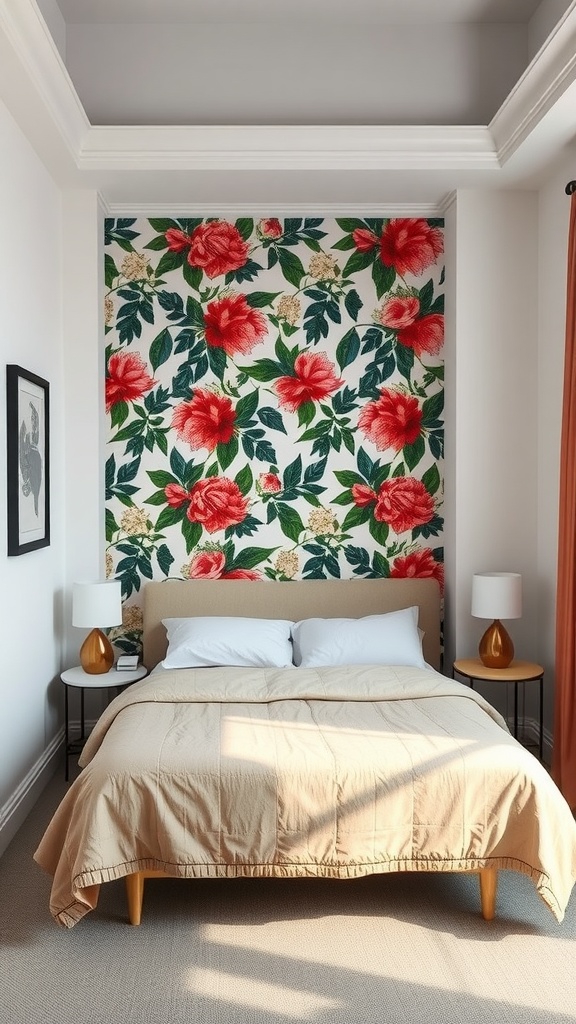
A feature wall can transform a small bedroom into a cozy retreat. In this image, the bold floral wallpaper stands out beautifully behind the bed, creating a focal point that draws the eye.
The vibrant reds and greens of the flowers add warmth and character. This type of wallpaper is perfect for small rooms since it introduces color and pattern without overwhelming the space.
Choosing wallpaper with large, bold designs can make the room feel more spacious. The contrast between the colorful wall and the neutral bedding keeps the overall look balanced and inviting.
To create your own feature wall, consider the mood you want to set. Bright floral patterns can energize a space, while softer tones can bring calm. Don’t forget to think about the other elements in the room, like furniture and decor, to ensure everything flows together.
Using Area Rugs to Define Spaces

In a small bedroom, area rugs can work wonders to define different zones. This cozy room showcases two beds, creating a shared space that feels inviting and personal. The area rug placed between the beds acts as a visual anchor, bringing together the two sleeping areas.
The choice of a patterned rug adds texture and warmth to the overall design. It not only provides comfort underfoot but also helps to delineate the sleeping area from the rest of the room, making the space feel more organized. This kind of separation is especially useful in smaller bedrooms where every inch counts.
Additionally, the soft colors of the rug complement the neutral walls and wooden furniture, creating a harmonious look. The rug can be a conversation starter, tying in colors or patterns from other decorative elements like the plants or the artwork on the walls.
Using an area rug in this manner can also make the bedroom feel larger. Instead of everything blending together, the rug visually separates the areas, giving a sense of depth. So, if you’re working with a small space, consider how an area rug can enhance both the look and feel of your bedroom.
Incorporating Sliding Doors for Space Efficiency

When it comes to small bedrooms, every inch counts. One stylish solution to make the most of your limited space is to use sliding doors. The image beautifully illustrates this concept, showing a pair of wooden sliding doors that open up into a cozy closet. These doors don’t swing out, which saves valuable floor space.
Sliding doors come in various styles, and the natural wood finish adds warmth to the room. This design choice can blend seamlessly with different types of decor. Plus, the sleek look of sliding doors can give your small bedroom a more open feeling, making it look less cramped and more inviting.
Another benefit of sliding doors is their ease of use. Unlike traditional doors that require space to swing open, sliding doors glide smoothly, allowing you to access your storage without hassle. This can be especially helpful when you have a bed positioned close to the closet.
In small room bedrooms, every detail matters. The combination of sliding doors and thoughtful design can transform your space, making it feel larger and more organized. If you’re looking to refresh your small bedroom, consider how sliding doors can enhance both style and functionality.
Choosing a Minimalistic Bed Frame
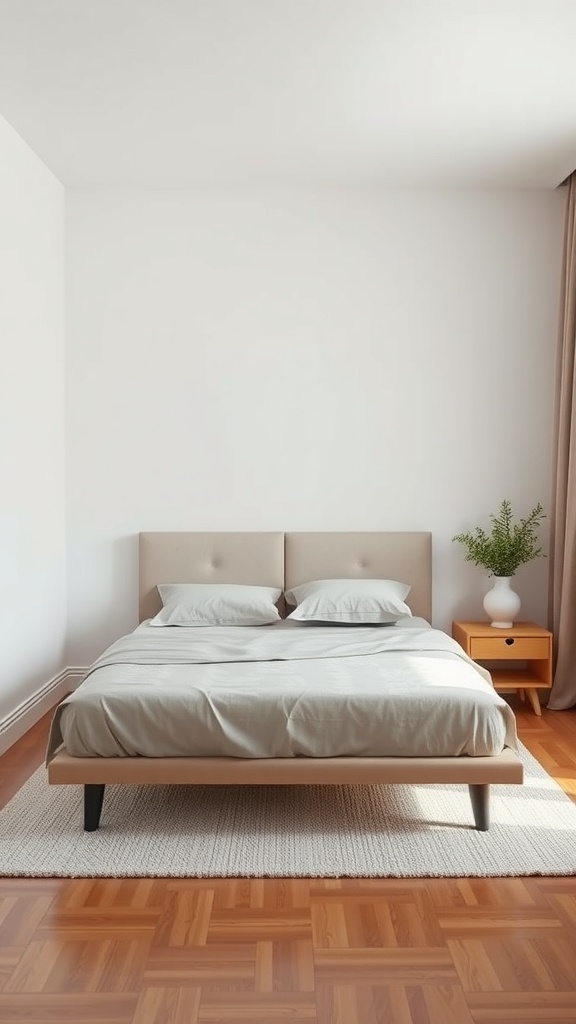
When it comes to decorating a small bedroom, selecting the right bed frame is key. A minimalistic bed frame not only saves space but also adds a clean and tidy look to your room. In the image above, we see a bed that embodies simplicity. Its soft, neutral colors create a calming atmosphere, making it an ideal choice for a cozy retreat.
The low-profile design of this bed frame keeps the room from feeling cramped. It allows for plenty of floor space, making the area feel larger than it is. Additionally, the subtle headboard adds a touch of comfort without overwhelming the design. This is crucial when you’re working with limited space.
Incorporating a minimalistic bed frame can also make decorating easier. With fewer elements to focus on, you can play around with accessories like bedding or throws. The natural wood tones in the frame and the warm hues of the floor also add warmth to the room, enhancing its inviting feel.
When choosing a bed frame, consider materials and colors that blend well with your existing decor. A light fabric or wood can brighten up the space, while darker tones might give it a more sophisticated look. Either way, simplicity is key. Keep things streamlined, and you’ll create a welcoming bedroom that feels organized and peaceful.
Employing Smart Lighting Solutions
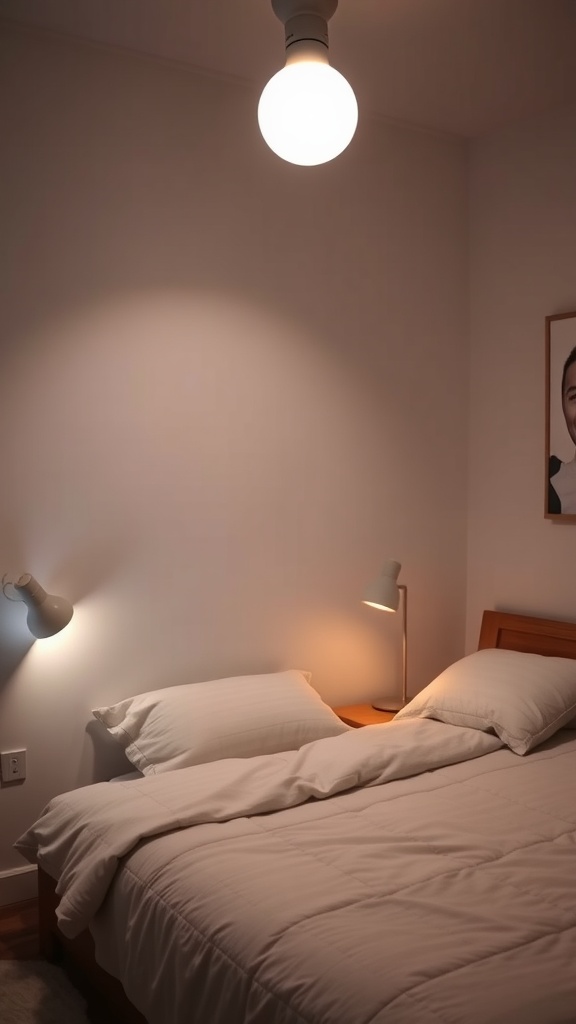
In a small room bedroom, lighting plays a crucial role in creating an inviting atmosphere. The image showcases a well-thought-out lighting arrangement that maximizes both function and style.
The overhead light provides general illumination, while the bedside lamps offer a cozy glow. This combination ensures that the room feels warm and comfortable, perfect for relaxation.
When choosing lighting for a small bedroom, consider adjustable options. The lamps shown here can be angled to focus light where it’s needed, whether for reading or simply creating a calming ambiance.
Another tip is to use dimmable lights. This feature allows you to customize the brightness, making it easy to switch from bright light during the day to a softer glow at night. Such versatility helps in setting the right mood for any occasion.
Lastly, consider the color temperature of the bulbs. Warmer lights can make a small space feel more inviting, while cooler lights may be better for energizing the area during the day.
Utilizing Dark Colors for Bold Contrast

In smaller bedrooms, using dark colors can create a cozy and intimate atmosphere. This image showcases a small room featuring a dark wall that adds depth and elegance. The contrast between the dark hue and the lighter furniture pieces makes the space feel both stylish and inviting.
The choice of dark colors is not just about aesthetics; it also helps to define the space. The dark wall creates a focal point, drawing the eye and making the room feel more cohesive. This can be particularly effective in small spaces where you want to create a feeling of continuity.
Accessorizing with lighter elements, like the white bedding and the light wood furniture, helps to balance the room. The combination of these colors not only enhances the overall design but also keeps the space from feeling overly cramped. Natural light filtering through the curtains adds warmth and softness, making the dark tones less overwhelming.
Incorporating textures, such as the soft bedding and the plush carpet, further enriches the room’s ambiance. This thoughtful layering of materials invites comfort, perfect for winding down after a long day. So, if you’re looking to make a bold statement in a small bedroom, consider embracing dark colors to create that striking contrast!
Adding a Wall-Mounted Desk
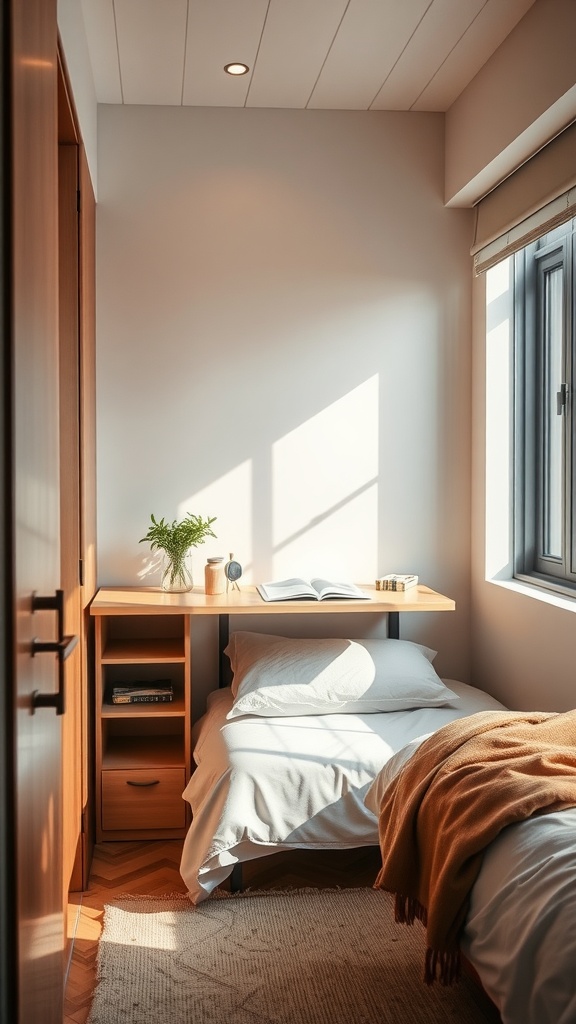
In a small bedroom, every bit of space matters. A wall-mounted desk is a smart addition that maximizes your room’s layout. It offers a dedicated workspace without taking up valuable floor area.
In the image, a cozy bedroom features a neatly placed wall-mounted desk. The desk blends seamlessly with the overall design, providing a functional spot for studying or working. The warm wood tones of the desk complement the soft bedding and create a balanced look.
Having a wall-mounted desk allows you to keep your essentials organized. You can place books, a small plant, and stationery on it, as shown in the image. This setup not only keeps things tidy but also adds a personal touch to your space.
Natural light streams in through the window, highlighting the desk area. This makes it an inviting spot for getting things done. A well-lit workspace can boost your mood and productivity, making it easier to focus on tasks.
Incorporating a Statement Piece
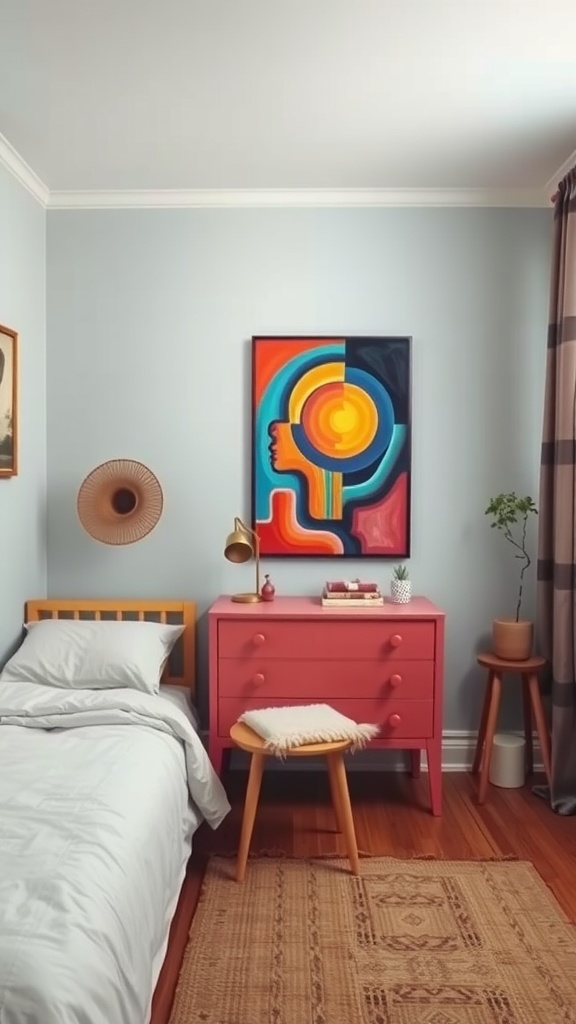
When designing a small bedroom, picking a statement piece can really tie the room together. In the image, a vibrant piece of artwork draws the eye immediately. It not only adds color but also sets a creative vibe. Statement pieces like this help create a focal point in a compact space, making it feel more inviting.
The bold colors in the artwork contrast nicely with the soft blue walls. This creates visual interest without overwhelming the small room. In small spaces, it’s crucial to balance bold elements with calming tones. This combination can help the room feel larger while still being stylish.
Another aspect to consider is the furniture around the statement piece. The simple bed frame and nightstand complement the artwork without competing with it. Choosing furniture that is understated yet functional can allow your statement piece to shine. This strategy makes the small bedroom feel organized and chic.
Finally, accents like the plant and the cozy stool add warmth without cluttering the space. When selecting your own statement piece, think about how it interacts with the rest of the room. Aim for harmony, and you’ll create a small bedroom that is both unique and comfortable.
Using Decorative Storage Boxes
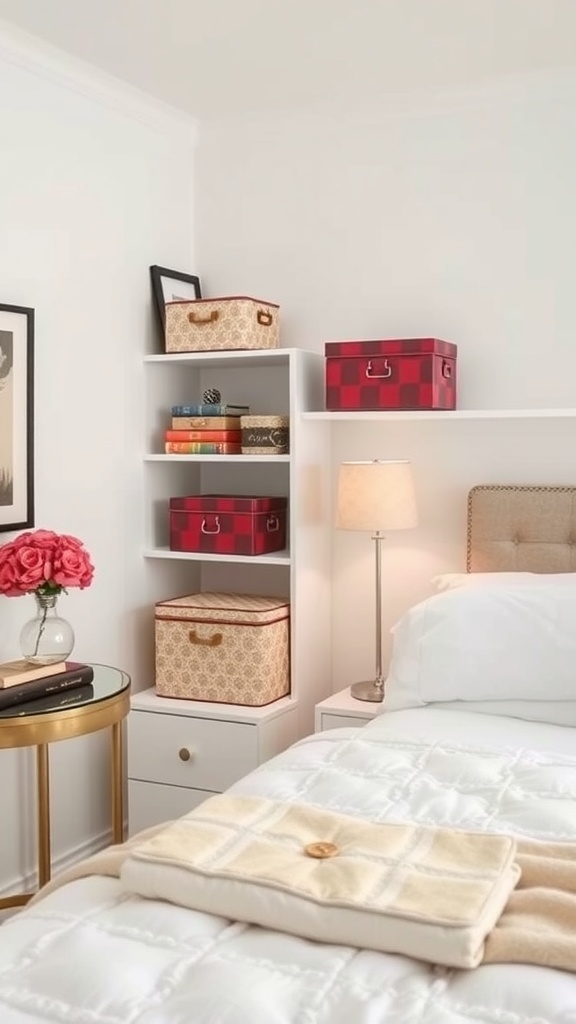
In a small bedroom, every inch of space counts, and decorative storage boxes are a smart solution. These boxes not only help keep things organized but also add a splash of style to your room.
In the image, you see a lovely setup that includes colorful storage boxes placed neatly on a shelf. The mix of patterns adds visual interest and makes the room feel more inviting. It’s a great way to store extra linens or seasonal clothing, keeping everything tidy but still easily accessible.
Using decorative boxes allows you to embrace your personal style. Choose colors or patterns that complement your bedding or wall color. This can create a cohesive look while still being functional.
Another benefit of storage boxes is versatility. You can use them in various ways, whether on shelves, under the bed, or even as side tables. The options are endless, and they can be arranged to fit your needs and space.
In this cozy setup, the lamp and flowers also add warmth, making the storage boxes a part of a well-thought-out design. Consider mixing and matching different sizes and shapes to create a unique storage solution that suits your small room perfectly.
Creating an Open Layout
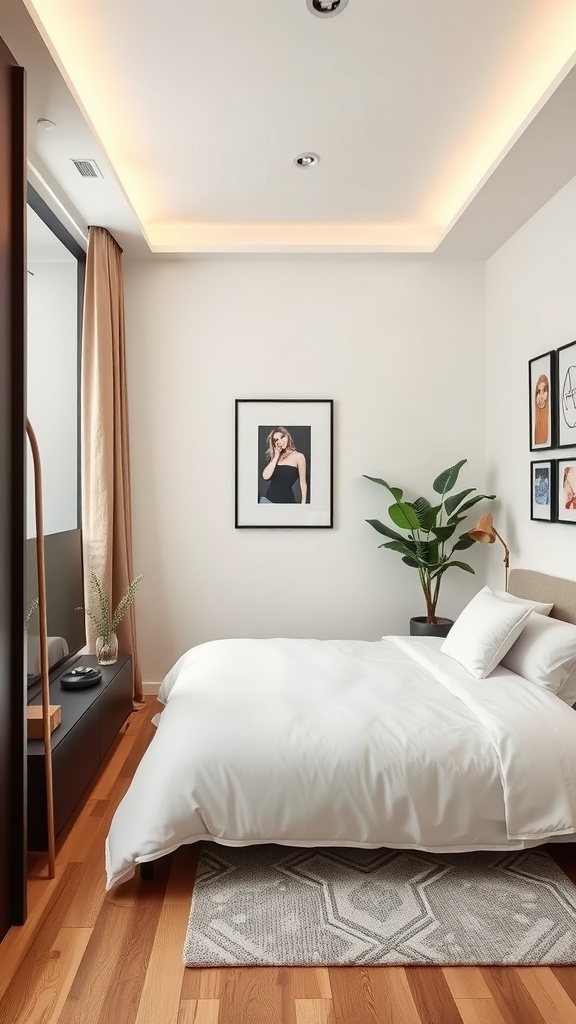
When working with a small bedroom, creating an open layout is essential. The image shows how to achieve a spacious feel, even in a cozy environment. A light color palette on the walls and ceiling helps reflect light, making the room look brighter and larger.
The bed is centered, allowing for easy movement around the space. The use of minimalist furniture keeps the area uncluttered. Notice how the side table is simple, providing just enough surface area for essentials without overwhelming the room.
Adding decorative elements like plants brings life into the space without taking up too much room. The framed art on the walls adds character and personal touch, inviting interest without crowding the surface area. Soft lighting from the ceiling creates a warm ambiance, enhancing the open and airy feel.
This layout not only makes the room functional but also enjoyable to be in. It encourages a sense of calm and relaxation, which is exactly what you want in a bedroom. Consider these elements when designing your own small bedroom for a cozy yet spacious vibe.
Creating a Personal Gallery
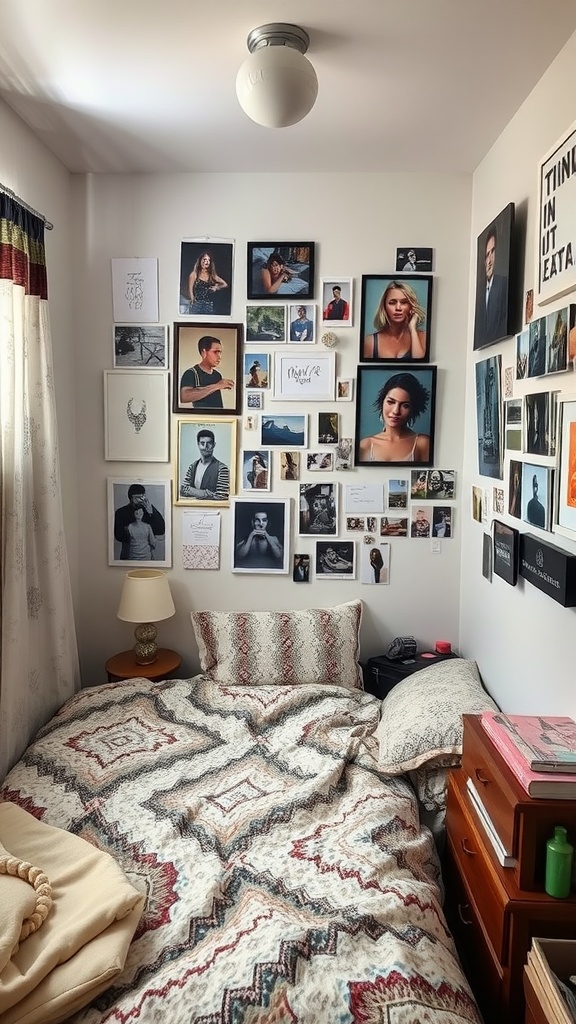
Turning a small bedroom into a personal gallery is a fun way to express yourself. The wall filled with framed photographs and art adds character to the space. Each piece tells a story, showcasing memories or inspirations that are meaningful to you.
The bed, with its cozy quilt, invites you to relax and reflect on the images surrounding you. Consider mixing different frame styles and sizes to create visual interest. It’s all about what resonates with you, so let your personality shine through.
Art isn’t just for large spaces; even small rooms can carry a big impact. Use the vertical space wisely, and don’t shy away from layering art. This approach makes your room feel more intimate and uniquely yours. Plus, every time you look at the gallery, it can spark joy or nostalgia.
Choosing a Low Bed for a Seamless Look
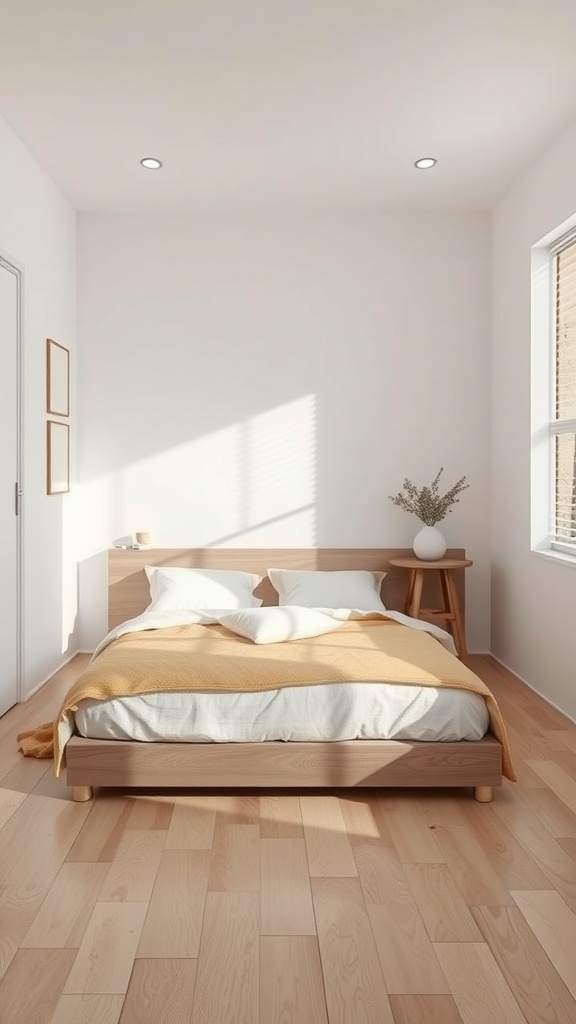
When designing a small bedroom, choosing the right bed can make a big difference. A low bed can create a seamless look that enhances the space. In the image, the bed is low to the ground, making the room feel more open and airy. This design choice not only saves space but also draws the eye across the room, making it appear larger.
The soft color palette, including the warm tones of the blanket, adds to the calm ambiance. A low bed paired with minimal decor balances the room’s overall aesthetic. The wooden elements, like the bed frame and side table, bring a touch of nature indoors, creating a cozy feeling.
Additionally, a low bed is easier to get in and out of, which is a practical benefit for any bedroom. This design is especially great for small spaces where every inch counts. By choosing a simple, low bed, you can maintain a clean and uncluttered look that makes your bedroom a relaxing retreat.
Utilizing Natural Light for Brightness
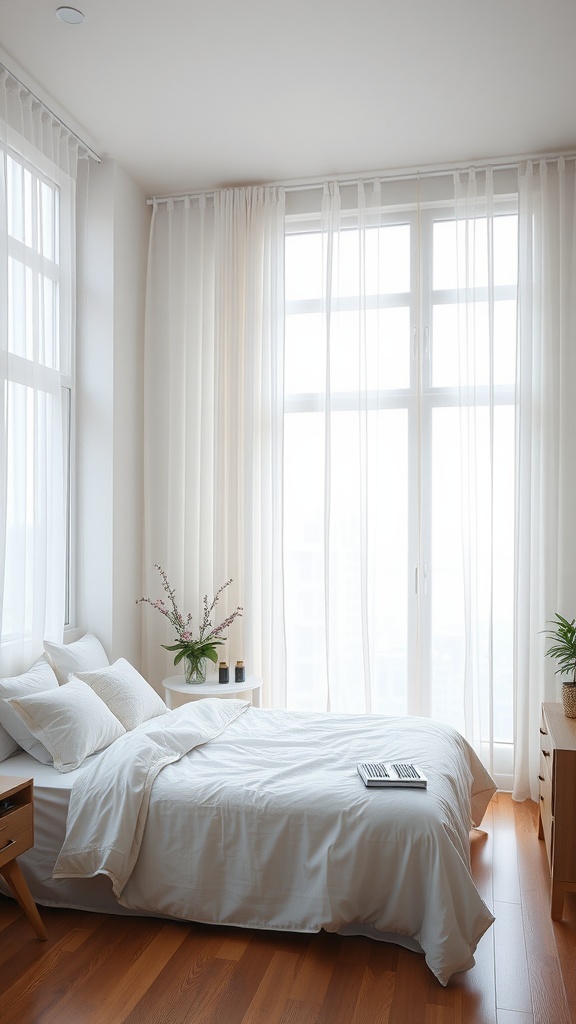
Natural light can transform a small bedroom into a bright and inviting space. In the image, large windows allow sunlight to flood the room, illuminating every corner. This not only makes the area feel larger but also boosts your mood, creating a cozy atmosphere.
The sheer curtains softly diffuse the light, adding a gentle touch while also maintaining privacy. Choosing light-colored fabrics encourages an airy feel, helping the room appear more open. A light palette is essential in small spaces, as it reflects light and creates a sense of depth.
Simple decorations, like the small plant and flowers on the bedside table, further enhance the ambiance. They bring a touch of nature indoors and complement the brightness provided by the natural light. Overall, incorporating large windows and light materials in your design can make a small bedroom feel warm and spacious.
Adding a Touch of Luxury with Fabrics

When it comes to small bedrooms, the right fabrics can elevate the entire space. In the image, we see an inviting bed adorned with plush pillows in warm tones. These choices bring not just comfort but also a sense of elegance.
The curtains play a crucial role here. The flowing, light fabric softens the natural light filtering through the window, creating a cozy atmosphere. This soft light enhances the room’s luxury without overwhelming it.
Textured fabrics, like those on the throw pillows, add depth to the decor. Mixing different textures, such as smooth linens with richer patterns, can make the space feel layered and sophisticated. A simple touch like this can turn a small room into a personal retreat.
Don’t overlook smaller details either. A decorative plate on the bed is not just functional; it adds to the room’s aesthetic. Choosing pieces that reflect personal style makes the space feel more curated and intentional.
Making Use of Corner Spaces
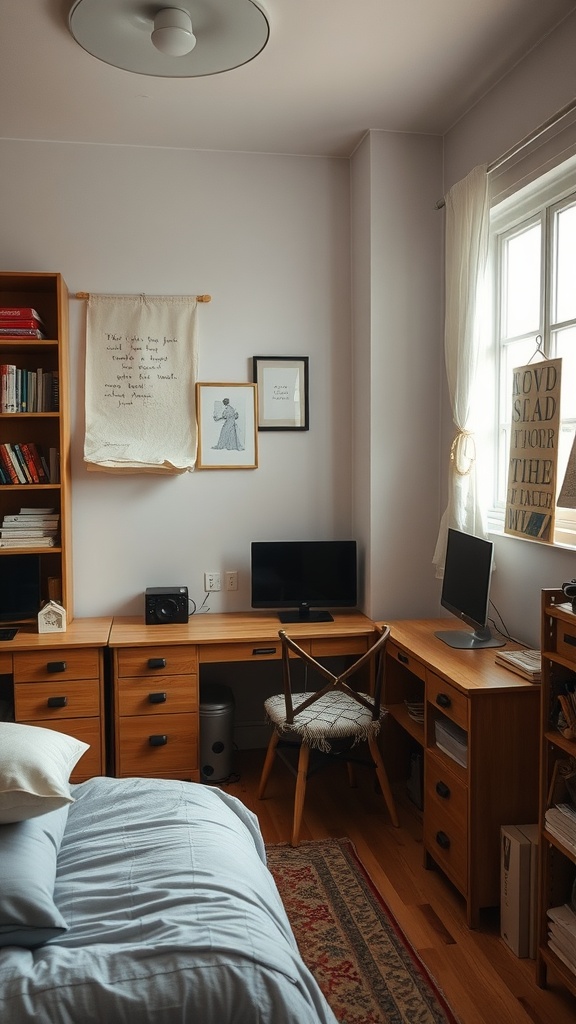
In a small bedroom, every inch counts. The image shows how to cleverly utilize corner spaces to create a functional and inviting area. Notice how the corner holds two desks, maximizing workspace without overwhelming the room.
This setup not only saves space but also offers a practical solution for those who need a dedicated work area. The light-colored wood of the desks adds warmth, while the clean lines keep the look tidy.
Another great feature is the placement of shelves above the desks. These shelves store books and decorative items, making use of vertical space. This is perfect for small rooms, where floor space is limited.
Let’s not forget the cozy bed in the corner! It’s a great way to keep the room open and airy, allowing for easy movement. The soft bedding enhances the room’s comfort while blending nicely with the overall design.
Incorporating art and personal touches, like the wall hangings and frames, adds character without cluttering the space. Overall, utilizing corner spaces like this transforms a small bedroom into a practical and inviting retreat.
Keeping Decor Minimal to Avoid Clutter
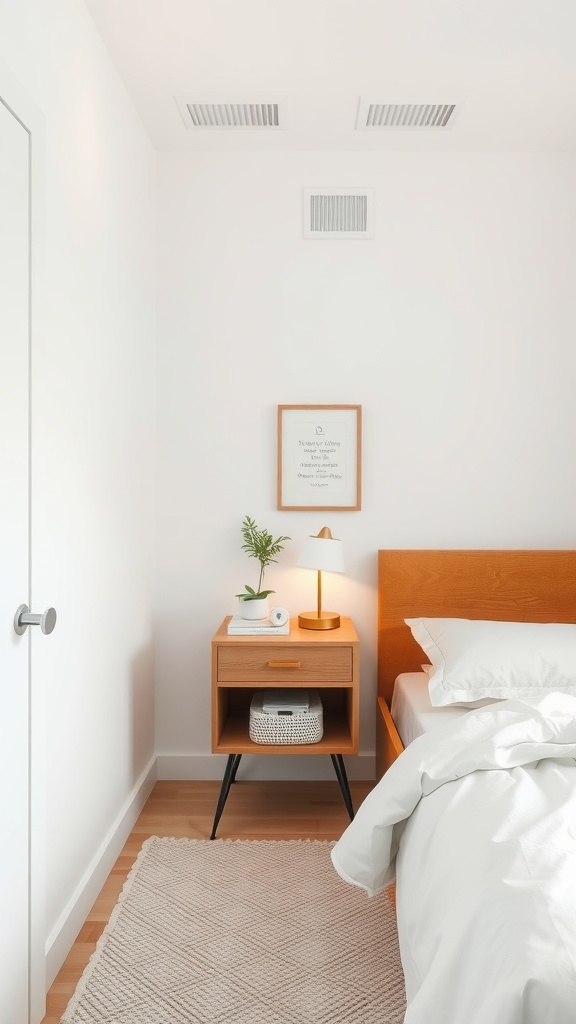
In a small room bedroom, less is often more. The image showcases a beautifully organized space that highlights the importance of minimal decor. A simple bed with crisp, white bedding creates a calm atmosphere, inviting rest and relaxation.
The nightstand plays a key role in maintaining this uncluttered look. With just a lamp, a small plant, and a few essentials, it serves its purpose without overwhelming the space. This is a great example of how choosing practical yet stylish furniture can make a room feel larger and more open.
Additionally, the light color palette enhances the feeling of space. The soft hues on the walls and the light wood flooring contribute to a bright, airy vibe. Incorporating textures, like the cozy rug, adds warmth without adding visual clutter.
Overall, keeping decor minimal is a smart strategy for small room bedrooms. It allows for a peaceful retreat while ensuring everything has its place. This approach can transform any small bedroom into a serene escape, making it the perfect spot to unwind at the end of the day.
